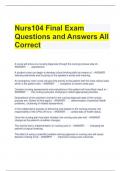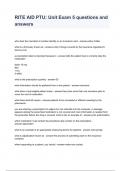Nurs104 Final Exam Questions and Answers All Correct A nurse will arrive at a nursing diagnosis through the nursing process step of: - ANSWER assessment. A student nurse can begin to develop critical thinking skills by means of: - ANSWER listening attentively and focusing on the speaker's words and meaning. An emergency room nurse will give first priority to the patient with the most critical need, which is the patient who: - ANSWER complains of severe chest pain. Constant nursing assessments and evaluations of the patient will most likely result in: - ANSWER the nursing care plan changing to reflect appr opriate priorities. Descriptions of the activities involved in the nursing diagnosis step of the nursing process are: (Select all that apply.) - ANSWER determination of potential health problems., clustering of related assessments. In the collabo rative process of delivering care based on the nursing process, the responsibility of the LPN/LVN is to: - ANSWER collect data of health status. Once the nursing plan has been initiated, the nursing care plan will: - ANSWER change as the p atient's condition changes. The activity that is implementation in nursing care is: - ANSWER changing the patient's surgical dressing. The effect of using a scientific problem -solving approach in nursing care will cause decision making to be: - ANSWER improved nursing care outcomes. The nurse who uses the nursing process will: - ANSWER approach the patient's disorder in a step -by-step method. The order in which the nursing process is approached is: - ANSWER assessment, nursing diagnosis, planning, implementation, evaluation. The participants of the planning stage of the nursing process during which the health goals are defined include the: - ANSWER health team, the patient, and the patient's family. When a nurse prioritizes the patient care, consideration is given to: - ANSWER considering situations that may result in an alteration of health. When a patient states, "I can't walk very well," the first problem -solving step would be to: - ANSWER find out what the problem is, such as weakness or poor balan ce. When a resident in the nursing home complains of constipation, the nurse performs a digital rectal examination and finds a hard fecal mass. This is an example of: - ANSWER assessment. When the nurse checks to see whether a patient has had rel ief 45 minutes after administering pain medication, the nurse is performing a(n): - ANSWER evaluation. A nursing care plan consists of: - ANSWER nursing orders for individualized interventions to assist the patient to meet expected outcome s. A nursing diagnosis consists of: - ANSWER diagnostic labels formulated by the North American Nursing Diagnosis Association -International (NANDA -I). A patient with visual impairment is identified as at risk for falls related to blindness. An appropriate intervention would be to: - ANSWER arrange furnishings in room to provide clear pathways and orient the patient to these. An elderly patient with a medical diagnosis of chronic lung disease has developed pneumonia. She is coughing freque ntly and expectorating thick, sticky secretions. She is very short of breath, even with oxygen running, and she is exhausted and says she "can't breathe." Based on this information, an appropriately worded nursing diagnosis for this patient is - ANSWER Airway clearance, ineffective, related to lung secretions as evidenced by cough and shortness of breath. During the assessment phase of the nursing process, the nurse - ANSWER gathers, organizes, and documents data in a logical database. The statements that are correctly stated as expected outcomes are: (Select all that apply.) - ANSWER Patient will be able to ambulate using a walker independently within 3 days., Patient will perform active range of motion (ROM) of her upper extremiti es independently every 4 hours. A nurse is caring for a patient with a medical diagnosis of right lower lobe pneumonia. The patient is expectorating thick green mucus, has an oxygen saturation level of 90%, and has audible crackles in the base of the righ t lung. An appropriate nursing diagnosis for this patient is: - ANSWER Airway clearance, ineffective, related to retained secretions as evidenced by expectoration of thick green mucus, oxygen saturation level of 90%, and audible crackles in the bas e of the right lung. A nursing care plan consists of: - ANSWER nursing orders for individualized interventions to assist the patient to meet expected outcomes. A nursing diagnosis consists of: - ANSWER diagnostic labels formulated by the North American Nursing Diagnosis Association -International (NANDA -I). A patient has a nursing diagnosis of Imbalanced nutrition: less than body requirements, related to mental impairment and decreased intake, as evidenced by increasing confusion and weigh t loss of more than 30 -pounds over the last 6 months. An appropriate short -term goal for this patient is to: - ANSWER eat 50% of six small meals each day by the end of 1 week. A patient with visual impairment is identified as at risk for falls related to blindness. An appropriate intervention would be to: - ANSWER arrange furnishings in room to provide clear pathways and orient the patient to these. After the admission assessment is completed, on subsequent shifts or days, the nurse: - ANSWER assesses the patient briefly in the first hour of the shift. Aside from the information obtained from the patient (primary source) in the admission interview, the nurse wil l also access: (Select all that apply - ANSWER the patient's family., the admission note., the physician's history and physical., an observation of the patient for non -verbal clues. If a patient has several nursing diagnoses, the nurse will first: - ANSWER prioritize the nursing problems according to Maslow's hierarchy of needs. In an acute care facility, a nursing care plan is usually reviewed and updated - ANSWER every 24 hours. The major goal of the admission interview (usually performed by the RN) is to: - ANSWER identify the patient's major complaints. The nurse clarifies that nursing orders are also called: - ANSWER interventions.





